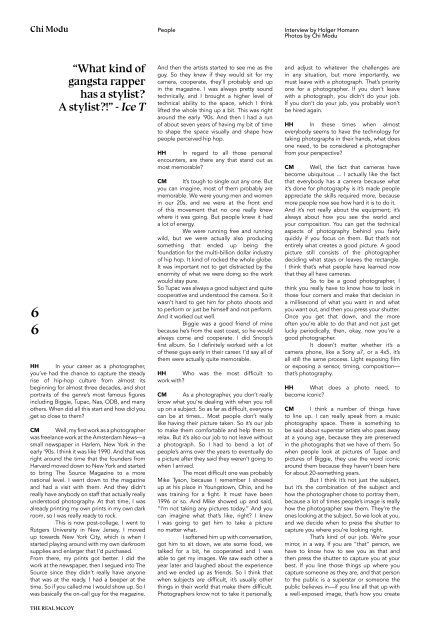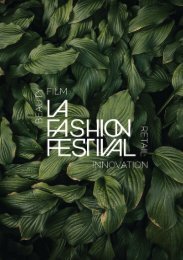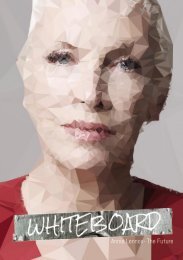Radical Vertical
The magazine is published in collaboration between radicalvertical, Berlin, kulturspace, Los Angeles & LAFFF.
The magazine is published in collaboration between radicalvertical, Berlin, kulturspace, Los Angeles & LAFFF.
Create successful ePaper yourself
Turn your PDF publications into a flip-book with our unique Google optimized e-Paper software.
Chi Modu<br />
People<br />
Interview by Holger Homann<br />
Photos by Chi Modu<br />
6<br />
6<br />
“What kind of<br />
gangsta rapper<br />
has a stylist?<br />
A stylist?!” - Ice T<br />
HH In your career as a photographer,<br />
you’ve had the chance to capture the steady<br />
rise of hip-hop culture from almost its<br />
beginning for almost three decades, and shot<br />
portraits of the genre’s most famous figures<br />
including Biggie, Tupac, Nas, ODB, and many<br />
others. When did all this start and how did you<br />
get so close to them?<br />
CM Well, my first work as a photographer<br />
was freelance work at the Amsterdam News—a<br />
small newspaper in Harlem, New York in the<br />
early ‘90s. I think it was like 1990. And that was<br />
right around the time that the founders from<br />
Harvard moved down to New York and started<br />
to bring The Source Magazine to a more<br />
national level. I went down to the magazine<br />
and had a visit with them. And they didn’t<br />
really have anybody on staff that actually really<br />
understood photography. At that time, I was<br />
already printing my own prints in my own dark<br />
room, so I was really ready to rock.<br />
This is now post-college. I went to<br />
Rutgers University in New Jersey, I moved<br />
up towards New York City, which is when I<br />
started playing around with my own darkroom<br />
supplies and enlarger that I’d purchased.<br />
From there, my prints got better. I did the<br />
work at the newspaper, then I segued into The<br />
Source since they didn’t really have anyone<br />
that was at the ready. I had a beeper at the<br />
time. So if you called me I would show up. So I<br />
was basically the on-call guy for the magazine.<br />
And then the artists started to see me as the<br />
guy. So they knew if they would sit for my<br />
camera, cooperate, they’ll probably end up<br />
in the magazine. I was always pretty sound<br />
technically, and I brought a higher level of<br />
technical ability to the space, which I think<br />
lifted the whole thing up a bit. This was right<br />
around the early ‘90s. And then I had a run<br />
of about seven years of having my bit of time<br />
to shape the space visually and shape how<br />
people perceived hip hop.<br />
HH In regard to all those personal<br />
encounters, are there any that stand out as<br />
most memorable?<br />
CM It’s tough to single out any one. But<br />
you can imagine, most of them probably are<br />
memorable. We were young men and women<br />
in our 20s, and we were at the front end<br />
of this movement that no one really knew<br />
where it was going. But people knew it had<br />
a lot of energy.<br />
We were running free and running<br />
wild, but we were actually also producing<br />
something that ended up being the<br />
foundation for the multi-billion dollar industry<br />
of hip hop. It kind of rocked the whole globe.<br />
It was important not to get distracted by the<br />
enormity of what we were doing so the work<br />
would stay pure.<br />
So Tupac was always a good subject and quite<br />
cooperative and understood the camera. So it<br />
wasn’t hard to get him for photo shoots and<br />
to perform or just be himself and not perform.<br />
And it worked out well.<br />
Biggie was a good friend of mine<br />
because he’s from the east coast, so he would<br />
always come and cooperate. I did Snoop’s<br />
first album. So I definitely worked with a lot<br />
of these guys early in their career. I’d say all of<br />
them were actually quite memorable.<br />
HH Who was the most difficult to<br />
work with?<br />
CM As a photographer, you don’t really<br />
know what you’re dealing with when you roll<br />
up on a subject. So as far as difficult, everyone<br />
can be at times... Most people don’t really<br />
like having their picture taken. So it’s our job<br />
to make them comfortable and help them to<br />
relax. But it’s also our job to not leave without<br />
a photograph. So I had to bend a lot of<br />
people’s arms over the years to eventually do<br />
a picture after they said they weren’t going to<br />
when I arrived.<br />
The most difficult one was probably<br />
Mike Tyson, because I remember I showed<br />
up at his place in Youngstown, Ohio, and he<br />
was training for a fight. It must have been<br />
1996 or so. And Mike showed up and said,<br />
“I’m not taking any pictures today.” And you<br />
can imagine what that’s like, right? I knew<br />
I was going to get him to take a picture<br />
no matter what.<br />
I softened him up with conversation,<br />
got him to sit down, we ate some food, we<br />
talked for a bit, he cooperated and I was<br />
able to get my images. We saw each other a<br />
year later and laughed about the experience<br />
and we ended up as friends. So I think that<br />
when subjects are difficult, it’s usually other<br />
things in their world that make them difficult.<br />
Photographers know not to take it personally,<br />
and adjust to whatever the challenges are<br />
in any situation, but more importantly, we<br />
must leave with a photograph. That’s priority<br />
one for a photographer. If you don’t leave<br />
with a photograph, you didn’t do your job.<br />
If you don’t do your job, you probably won’t<br />
be hired again.<br />
HH In these times when almost<br />
everybody seems to have the technology for<br />
taking photographs in their hands, what does<br />
one need, to be considered a photographer<br />
from your perspective?<br />
CM Well, the fact that cameras have<br />
become ubiquitous ... I actually like the fact<br />
that everybody has a camera because what<br />
it’s done for photography is it’s made people<br />
appreciate the skills required more, because<br />
more people now see how hard it is to do it.<br />
And it’s not really about the equipment; it’s<br />
always about how you see the world and<br />
your composition. You can get the technical<br />
aspects of photography behind you fairly<br />
quickly if you focus on them. But that’s not<br />
entirely what creates a good picture. A good<br />
picture still consists of the photographer<br />
deciding what stays or leaves the rectangle.<br />
I think that’s what people have learned now<br />
that they all have cameras.<br />
So to be a good photographer, I<br />
think you really have to know how to look in<br />
those four corners and make that decision in<br />
a millisecond of what you want in and what<br />
you want out, and then you press your shutter.<br />
Once you get that down, and the more<br />
often you’re able to do that and not just get<br />
lucky periodically, then, okay, now you’re a<br />
good photographer.<br />
It doesn’t matter whether it’s a<br />
camera phone, like a Sony a7, or a 4x5, it’s<br />
all still the same process. Light exposing film<br />
or exposing a sensor, timing, composition—<br />
that’s photography.<br />
HH What does a photo need, to<br />
become iconic?<br />
CM I think a number of things have<br />
to line up. I can really speak from a music<br />
photography space. There is something to<br />
be said about superstar artists who pass away<br />
at a young age, because they are preserved<br />
in the photographs that we have of them. So<br />
when people look at pictures of Tupac and<br />
pictures of Biggie, they use the word iconic<br />
around them because they haven’t been here<br />
for about 20-something years.<br />
But I think it’s not just the subject,<br />
but it’s the combination of the subject and<br />
how the photographer chose to portray them,<br />
because a lot of times people’s image is really<br />
how the photographer saw them. They’re the<br />
ones looking at the subject. So we look at you,<br />
and we decide when to press the shutter to<br />
capture you where you’re looking right.<br />
That’s kind of our job. We’re your<br />
mirror, in a way. If you are “that” person, we<br />
have to know how to see you as that and<br />
then press the shutter to capture you at your<br />
best. If you line those things up where you<br />
capture someone as they are, and that person<br />
to the public is a superstar or someone the<br />
public believes in—if you line all that up with<br />
a well-exposed image, that’s how you create<br />
THE REAL MCCOY





